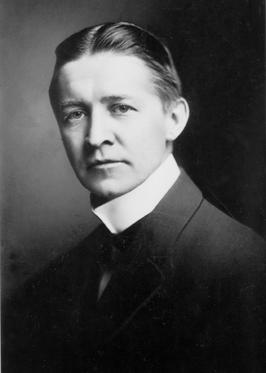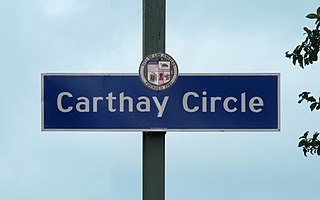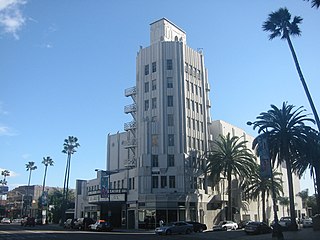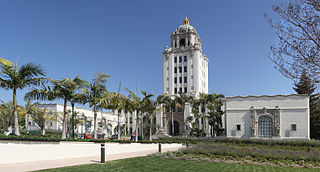
The Spanish Colonial Revival Style is an architectural stylistic movement arising in the early 20th century based on the Spanish Colonial architecture of the Spanish colonization of the Americas.
Charles Willard Moore was an American architect, educator, writer, Fellow of the American Institute of Architects, and winner of the AIA Gold Medal in 1991. He is often labeled as the father of postmodernism. His work as an educator was important to a generation of American architects who read his books or studied with him at one of the several universities where he taught.

Bertram Grosvenor Goodhue was an American architect celebrated for his work in Gothic Revival and Spanish Colonial Revival design. He also designed notable typefaces, including Cheltenham and Merrymount for the Merrymount Press. Later in life, Goodhue freed his architectural style with works like El Fureidis in Montecito, one of the three estates designed by Goodhue.

Postmodern architecture is a style or movement which emerged in the late 1950s as a reaction against the austerity, formality, and lack of variety of modern architecture, particularly in the international style advocated by Philip Johnson and Henry-Russell Hitchcock. The movement was introduced by the architect and urban planner Denise Scott Brown and architectural theorist Robert Venturi in their 1972 book Learning from Las Vegas. The style flourished from the 1980s through the 1990s, particularly in the work of Scott Brown & Venturi, Philip Johnson, Charles Moore and Michael Graves. In the late 1990s, it divided into a multitude of new tendencies, including high-tech architecture, neo-futurism, new classical architecture, and deconstructivism. However, some buildings built after this period are still considered postmodern.

Carthay Circle is a neighborhood in the Mid-City West region of Central Los Angeles, California. Originally named Carthay Center, the neighborhood was later renamed after the famed Carthay Circle Theatre.

The Saban Theatre is a historic theatre in Beverly Hills, California, formerly known as the Fox Wilshire Theater. It is an Art Deco structure at the southeast corner of Wilshire Boulevard and Hamilton Drive designed by architect S. Charles Lee and is considered a classic Los Angeles landmark. The building was listed on the National Register of Historic Places on April 3, 2012.

Myron Hubbard Hunt was an American architect whose numerous projects include many noted landmarks in Southern California and Evanston, Illinois. Hunt was elected a Fellow in the American Institute of Architects in 1908.
Barton Myers is an American architect and president of Barton Myers Associates Inc. in Santa Barbara, California. With a career spanning more than 40 years, Myers is a fellow of the American Institute of Architects and was a member of the Ontario Association of Architects while working in Canada earlier in his career.

Hugo Ballin was an American artist, muralist, author, and film director. Ballin was a member of the National Institute of Arts and Letters and the National Academy of Design.

The Beverly Hills Public Library is a public library in Beverly Hills, California.
Frederick M. Nicholas is an American lawyer specializing in real estate development and leases. He is known as "Mr. Downtown Culture" for his role in building the Museum of Contemporary Art, Los Angeles, the Geffen Contemporary, the Walt Disney Concert Hall, and for the founding of Public Counsel, the nation's largest public interest law firm. Frederick M. Nicholas has combined his legal career with a heavy real estate involvement to become an institution builder in the arts in Los Angeles.

The Mission Revival style was part of an architectural movement, beginning in the late 19th century, for the revival and reinterpretation of American colonial styles. Mission Revival drew inspiration from the late 18th and early 19th century Spanish missions in California. It is sometimes termed California Mission Revival, particularly when used elsewhere, such as in New Mexico and Texas which have their own unique regional architectural styles. In Australia, the style is known as Spanish Mission.

The Beverly Hills City Hall is a historic building and city hall in Beverly Hills, California, United States.

Brad Howe is an American sculptor from California. His work has been exhibited domestically and internationally.
R. Kenton Nelson is an American painter and contemporary artist from California.
Michael C. McMillen is a sculptor, installation artist, and short filmmaker from Los Angeles, California.

The old Beverly Hills Main Post Office is a Renaissance Revival building at the Beverly Hills Civic Center in Beverly Hills, California. The building has carried the addresses 469 North Crescent Drive and 470 North Canon Drive. It was built as the main post office in the 1930s, remaining a post office until the 1990s, and in the 2010s became the Paula Kent Meehan Historic Building of the Wallis Annenberg Center for the Performing Arts.
Ball-Nogues Studio is a design and fabrication practice based in Los Angeles, California. Founded by Benjamin Ball and Gaston Nogues, the studio's work falls between the categories of art, architecture and industrial design. The practice is known for creating site-specific architectural installations out of unorthodox materials such as stainless steel ball-chain and spheres, paper pulp, garments, and coffee tables. The studio focuses on the process of creation, with an emphasis on the research and exploration of materials and fabrication methods. Much of the studio's work involves expanding the potential of materials and manufacturing techniques.















